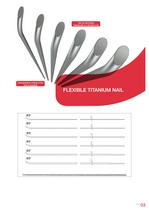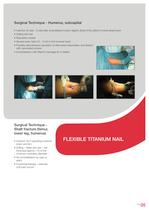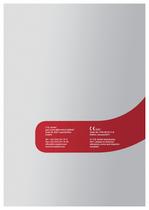
Catalog excerpts

FTN FLEXIBLE TITANIUM NAIL emergency team for broken bones®
Open the catalog to page 1
Preface Summary When used in appropriate indications, flexible titanium nails offer the possibility for early functional treatment including minimally invasive fracture reposition, retention with elastical stable medullary nailing allowing for undisturbed periosteal bone healing. This technique is particularly suitable for children and adolescents when epiphyseal plates are still open, and partially in patients with osteoporotic fractures (shoulder). Benefits are the minimally invasive surgical technique avoiding open reposition and soft tissue irritation, and the chance for undisturbed...
Open the catalog to page 2
can be shortened individually in a flexible way intraoperative cutting of the nail is possible FLEXIBLE TITANIUM NAIL i.t.s. 03
Open the catalog to page 3
Surgical Technique - Forearm fracture • adial insertion distally at the styloid process – ulnar insertion (sparing R soft tissue) from proximal at the olecranon. • ail thickness approx. 1/3 to 1/2 of the minimum medullary diameter. N • ails should be inserted into the opposite corticalis (radial head or distal N ulna, respectively), otherwise there is a risk of delayed fracture healing. • o cast required for immobilisation N • unctional therapy, allows for exercise until pain indicates exact F reposition FLEXIBLE TITANIUM NAIL emergency team for broken bones® 04 i.t.s.
Open the catalog to page 4
Surgical Technique - Humerus, subcapital • nsertion of nails - 3 nails after anterolateral incision slightly distal of the deltoid muscle attachment I • rilling with awl D • eposition closed R • pread open nails 2.5 - 3 mm in the humeral head S • ossibly percutaneous reposition of dislocated tuberosities, and fixation P with cannulated screws • mmobilisation with Resch’s bandage for 3 weeks I Surgical Technique Shaft fracture (femur, lower leg, humerus) • nsertion via 2 opposing incisions I (med. and lat.) • rilling – dilate with awl – nail D thickness approx. 1/3 of the minimum medullary...
Open the catalog to page 5
Surgical Technique - Supracondylar humeral fracture in children • losed reposition C • nsertion of 2 nails from proximal I • ast for 3 week rest C FLEXIBLE TITANIUM NAIL emergency team for broken bones® Surgical Technique - Metacarpal – metatarsal V: • ncision I • rilling D • epositioning with nails R Nail removal Early after bony consolidation 06 i.t.s.
Open the catalog to page 6
Case reports FLEXIBLE TITANIUM NAIL Implant Order No. 1 Titanium Nail, Flexible, D=2.0mm, L=400 mm 1920-400 2 Titanium Nail, Flexible, D=2.5mm, L=400 mm 1925-400 3 Titanium Nail, Flexible, D=3.0mm, L=400 mm 1930-400 4 Titanium Nail, Flexible, D=3.5mm, L=400 mm 1935-400 5 Titanium Nail, Flexible, D=4.0mm, L=400 mm 1940-400 6 Titanium Nail, Flexible, D=4.5mm, L=400 mm 1945-400 i.t.s. 07
Open the catalog to page 7
® DOTIZE Chemical process - anodization in a strong alkaline solution * Type III anodization Dotize Type II anodization Layer thickness 60-200nm Layer thickness 2000-10 000nm + Different colors + Film become an interstitial part of the titanium - Implant surface remains sensitive to: Chipping Peeling Discoloration - No visible cosmetical effect Anodization Type II leads to following benefits * • • • • • • • • Oxygen and silicon absorbing conversion layer Decrease in protein adsorption Closing of micro pores and micro cracks Reduced risk of inflammation and allergy Hardened titanium surface...
Open the catalog to page 8
Sterilization Guidelines The following remarks should serve as a guideline in the sterilization of medical products. IMPORTANT INDICATIONS FOR DOCTORS AND OPERATING THEATRE PERSONNEL This instruction leaflet refers to all supplied nonsterile implants and all reusable instruments from I.T.S. GmbH. Detailed information for the identification of the product (such as system classification, cat. no.) can be found in the product identification code and/ or on the package label. Make sure that you are familiar with the possibilities of application, combinability and correct handling of the...
Open the catalog to page 10
Sterilization Guidelines Disinfection Equipment: Commercially available disinfectants authorized for use with medical products e.g.. MEDICLEAN FORTE) can be used (but only according to the instructions of the disinfectant producer). In the case of automatic cleaning, a final rinse cycle at 90 °C for 5 minutes can be finally carried out to provide thermal disinfection. Drying Drying as part of the cleaning/ disinfection cycle should not exceed 110 °C. Checking, Maintenance and Inspection • Each instrument or implant is to be inspected carefully to make sure that all visible dirt has been...
Open the catalog to page 11
part of the MED-HOLD GROUP alterations, errors and misprints
Open the catalog to page 12All I.T.S. catalogs and technical brochures
-
ufs
1 Pages
-
DHL
2 Pages
-
ITS
2 Pages
-
PHL
24 Pages
-
ACLS
20 Pages
-
CFN
32 Pages
-
OLS
24 Pages
-
PHLs
20 Pages
-
CTN - Cannulated Tibia Nail
28 Pages
-
SR Sacral Rods
20 Pages
-
HCS
24 Pages
-
TOS Twist-Off Screw
20 Pages
-
TLS
20 Pages
-
PRS-RX
32 Pages
-
HLS
20 Pages
-
ES
20 Pages
-
SR
20 Pages
-
FL
24 Pages
-
PL - Pilon Locking Plate small
12 Pages
-
OL - Olecranon Locking Plate
24 Pages
-
CAS
40 Pages
-
FCN
20 Pages
-
HOL
24 Pages
-
FLS
24 Pages
-
PFL
20 Pages
-
DTL
24 Pages
-
HTO
24 Pages
-
PTL
32 Pages
-
DFL
32 Pages
-
SCL
32 Pages
-
SLS
24 Pages
-
CAL
20 Pages
-
DUL
24 Pages
-
CLS
28 Pages



























































